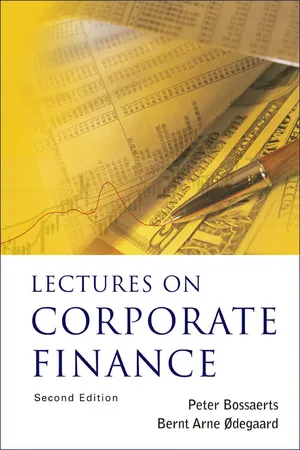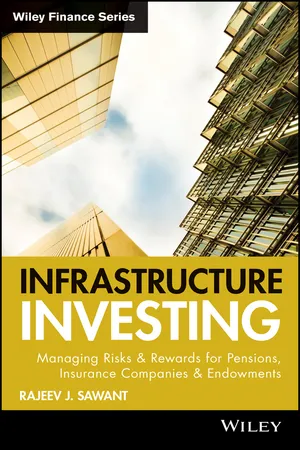Business
Modigliani-Miller Formula
The Modigliani-Miller formula, developed by economists Franco Modigliani and Merton Miller, is a theorem that states that in a perfect market, the value of a firm is not affected by its capital structure. This means that the way a company finances its operations, whether through debt or equity, does not impact its overall value if certain conditions are met.
Written by Perlego with AI-assistance
Related key terms
Related key terms
1 of 4
Related key terms
1 of 3
4 Key excerpts on "Modigliani-Miller Formula"
- eBook - ePub
- Peter Bossaerts, Bernt Arne Ødegaard(Authors)
- 2006(Publication Date)
- WSPC(Publisher)
next chapter we will look at conditions that make that intuition break down. In particular we look at how taxes affect things.17.2 The Capital Structure Problem when Assets are In Place: Modigliani Miller IWe will provide a clear answer to the capital structure problem under the assumption that the company's assets are already “in place”. By that we mean that investment took place and is irreversible. It can then be shown that the value of the firm does not depend on the debt/equity mix. Showing this is one of the most famous results in finance, the Modigliani Miller Theorem I (MM I).The main result can be stated asIf we assume that the change in financing mix does not affect the total cash flows of the firm accruing to the shareholders and bondholders, changing the debt/equity ratio does not change V, the value of the firm.Intuitively, it can't possibly affect V, because “same cash flows implies same value.” Otherwise there would be an arbitrage opportunity (free lunch). In their original proof of the above proposition, Modigliani and Miller exploited the arbitrage opportunity in an ingenious way. We will go through their argument. Assume there are two firms, a levered one (one with both debt and equity), with value VL , and an unlevered one (one with only equity), with value VU Debt is perpetual, paying a coupon C per period. All cashflows are risk free, hence we can discount future coupon payments C at the risk free rate r to find the value of debt BL :Now let EL and EU denote the value of equity in the levered and unlevered firm, respectively. Of course, EU = VU . For simplicity, suppose both firms earn a perpetual stream of F dollars per period. The levered firm pays C out of F and passes the remainder, F — C, to the shareholders. The unlevered firm passes on the entire flow F to shareholders. If the debt equity mix does not affect firm value, VU = VL - eBook - ePub
Infrastructure Investing
Managing Risks & Rewards for Pensions, Insurance Companies & Endowments
- Rajeev J. Sawant(Author)
- 2010(Publication Date)
- Wiley(Publisher)
In a Miller Modigliani world, the value of the firm does not depend on how much equity and debt the firm uses. Of course, the result is based on assumptions of perfect functioning of capital markets and that investment strategies of the firm are fixed. Stiglitz (1969, 1974) argued that in addition to perfect capital markets, a necessary assumption for the Miller Modigliani theorem to hold was that the debt held by firms and individuals was default-free. 2 However, Miller and Fama (1972) argued that the theorem held even when the debt held by individuals and firms was not default-free, if stockholders and debt holders protected themselves by seniority rules. 3 Miller and Fama called these me-first rules, and assumed them to be enforced costlessly and designed to protect existing debt holders by ensuring that the value of outstanding debt did not change if the firm altered its capital structure. For example, existing bondholders would insist on covenants that new debt remain junior to them. Me-first rules ensured that new financing did not undermine the position of existing debt. Fama (1978) argued that the assumptions for riskless debt or me-first rules were not necessary for the Miller Modigliani theorem to hold. 4 If stockholders wanted to issue unprotected debt (debt without me-first rules) then investors would be willing to hold them at the right price; in other words, investors acting rationally would price these securities assuming that stockholders would act opportunistically. In a Miller-Modigliani world without taxation we should find a uniform capital structure for all firms. In a world with taxation we should find firms financed almost entirely with debt since debt provides tax shields. Firms would seek to minimize taxes and use high interest payments to shield their wealth from taxes. The financial innovations that have been such a vital part of modern capital markets would be absent since theoretically these do not matter - eBook - ePub
- (Author)
- 2023(Publication Date)
- Wiley(Publisher)
Issuers generally aim to minimize their weighted-average cost of capital and to match the duration of their assets and financing. Managements’ target capital structures are usually stated using book values or indirectly through financial leverage ratios, such as a maximum ratio of debt or net debt to EBITDA or a minimum credit rating.While management has some influence, the total amount and type of financing needed or the weights in the WACC calculation often depends on the issuer’s business model (e.g., capital intensive or capital light) and on the company’s life cycle stage.The component costs of debt and equity are determined by top-down factors, such as financial market and industry conditions, and by issuer-specific factors, including the stability of revenues and operating and financial leverage.Modigliani and Miller (MM) showed, under a restrictive set of assumptions including no taxes, that an issuer’s capital structure is irrelevant to firm value. MM relaxed the assumptions by considering corporate taxes, financial distress, and bankruptcy costs and showed that capital structure does matter, although far less than an issuer’s future cash flows, for firm value.Under MM’s static trade-off theory of capital structure, the optimal capital structure occurs where the tax benefit of debt equals the financial distress costs associated with debt.The pecking order theory of capital structure is an alternative to the static theory and suggests that a firm will use internal financing as much as possible. If external financing is needed, the firm prefers private debt over public debt and will limit the use of equity financing if possible. - eBook - ePub
The Right Balance for Banks
Theory and Evidence on Optimal Capital Requirements
- William Cline(Author)
- 2017(Publication Date)
chapter 4 apply this value for the M&M offset parameter in arriving at estimates of optimal capital requirements.Appendix 3A The Modigliani-Miller ModelModigliani and Miller (1958 , 267–71) posit that for any given “class” of firms (implicitly, for example, a particular industrial sector), in the absence of any debt financing the price of a share of a given firm j will be the expected annual stream of income earned (“expected return”) discounted by the expected rate of return for that class. Thus:or equivalently:where ρj is the share price of firm j, –jis the annual future steady stream of returns (earnings, abstracting from taxes) per share, and ρ is the characteristic rate of return to that class of firms. 28They then introduce debt financing and examine its influence on share pricing. Their first proposition is that “the market value of any firm is independent of its capital structure and is given by capitalizing its expected return at the rate ρk appropriate to its class” (p. 268). Thus:where Vj is the market value of the firm, Sj is the market value of its common shares, is expected return on assets owned by the company (before deduction of interest), and Dj is the market value of the debt of the company. 29The authors define the “average cost of capital” as the ratio of expected return to the market value of all the firm’s securities. Their proposition is then that this average cost is constant at the rate ρ applicable to the class in question, and consequently is “completely independent of the capital structure and is equal to the capitalization rate of a pure equity stream of its class” (p. 268). Thus:
Index pages curate the most relevant extracts from our library of academic textbooks. They’ve been created using an in-house natural language model (NLM), each adding context and meaning to key research topics.
Explore more topic indexes
Explore more topic indexes
1 of 6
Explore more topic indexes
1 of 4



